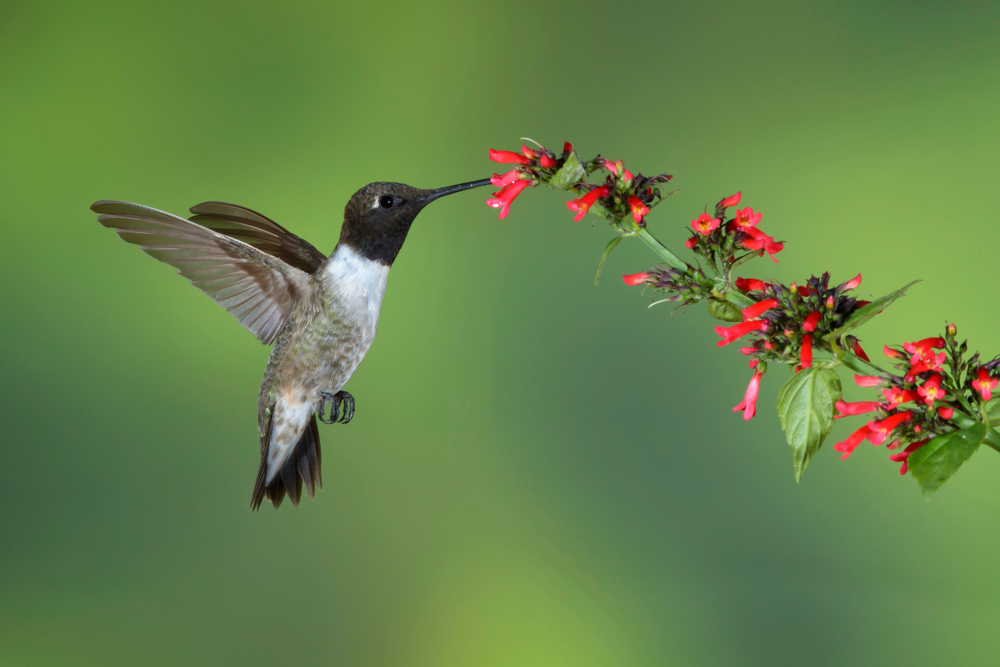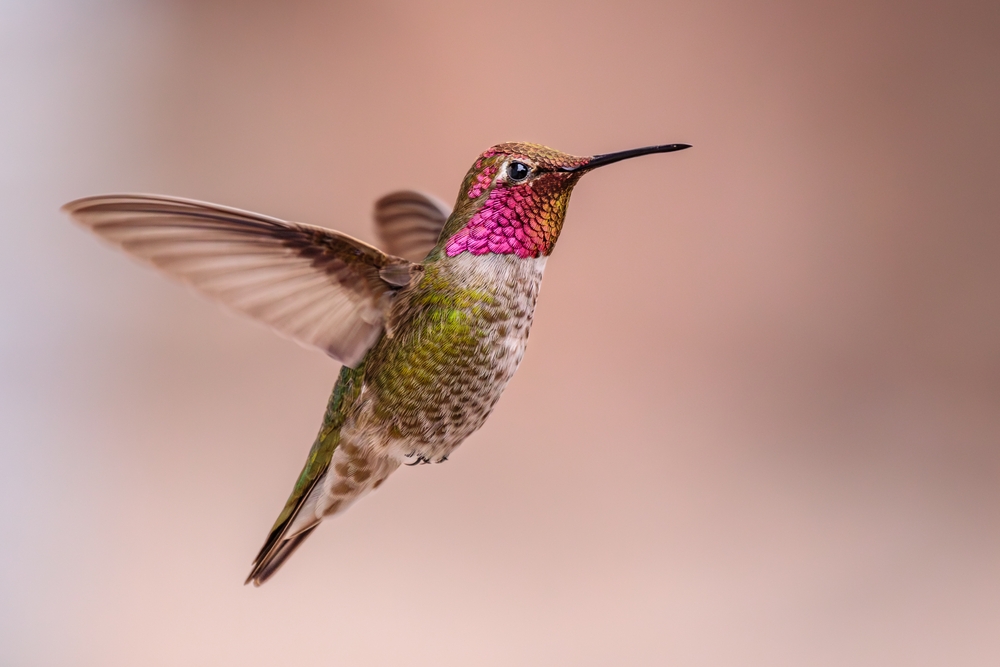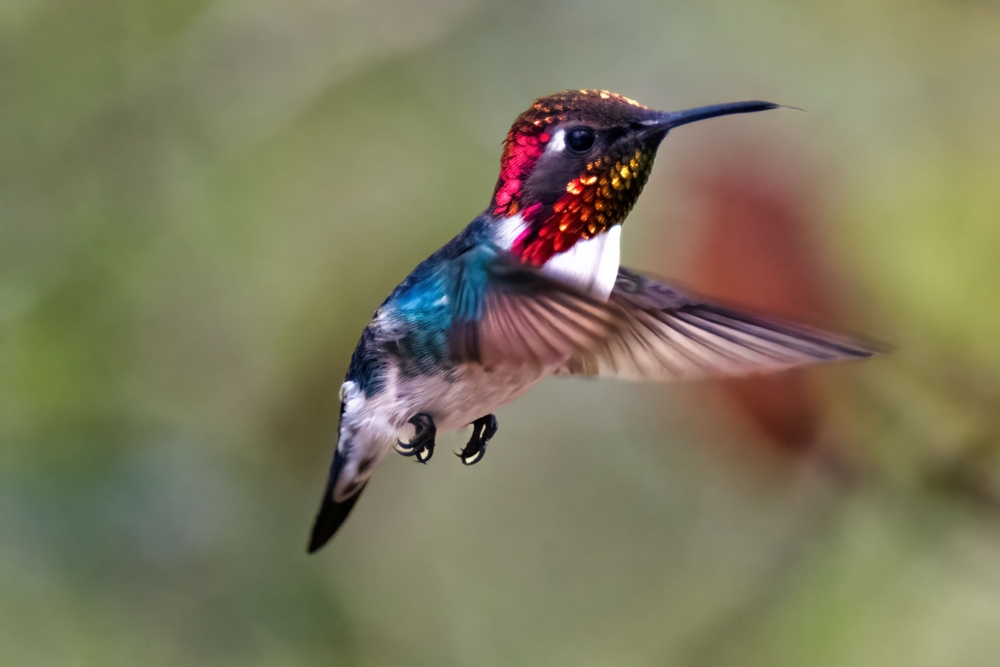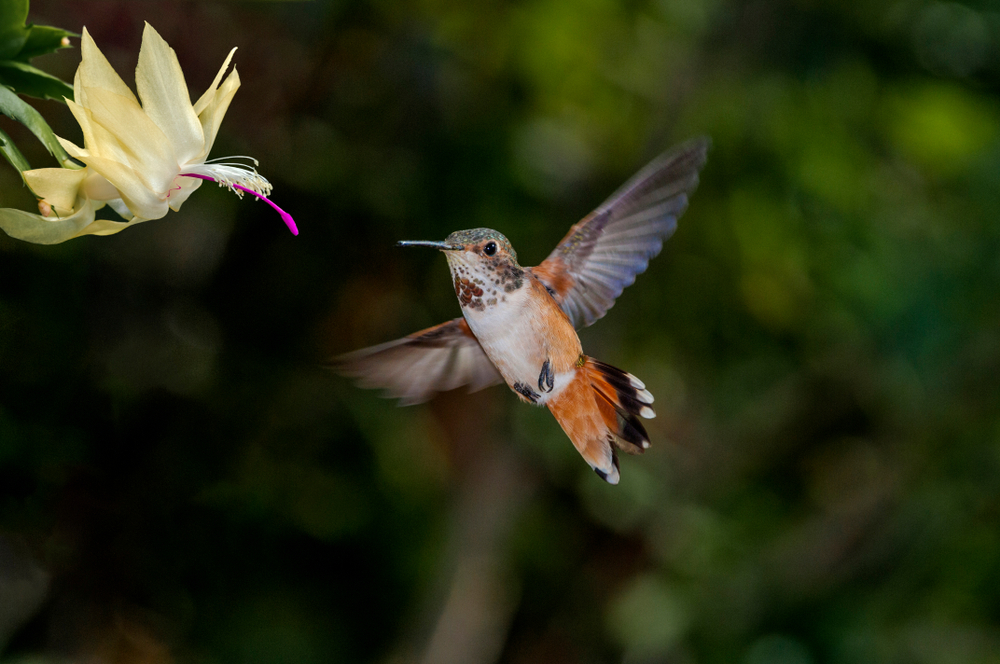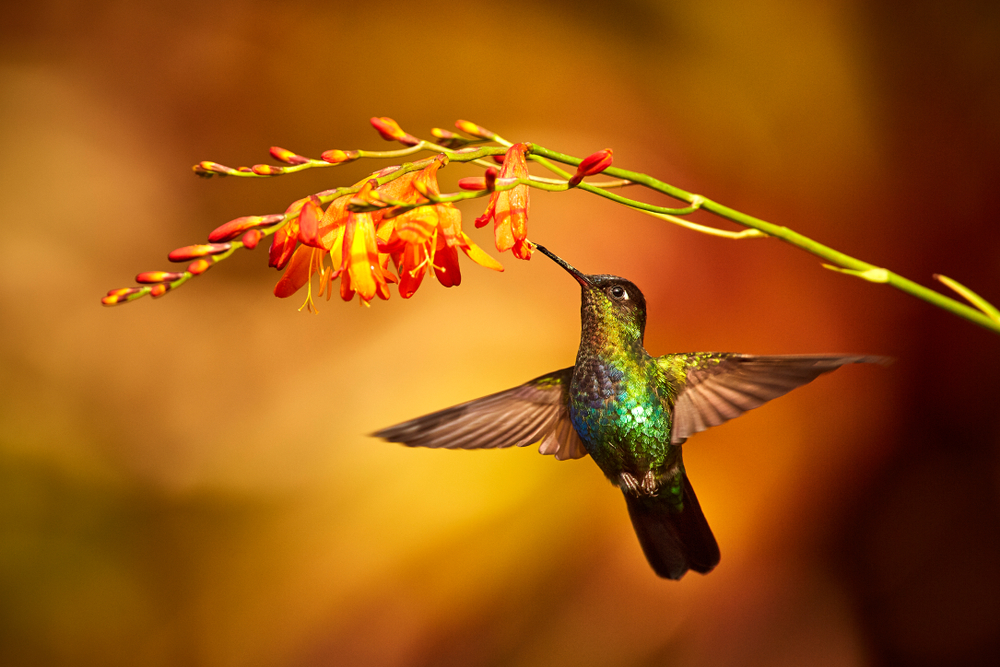The Black-chinned Hummingbird (Archilochus alexandri) is most closely related to the Ruby-throated Hummingbird (Archilochus colubris), its eastern counterpart. Both share similar size, structure, and behaviors but differ in range and gorget coloration.
About
The Black-chinned Hummingbird (Archilochus alexandri) is a small, adaptable species of the family Trochilidae, widely distributed across the western United States, northern Mexico, and parts of the southern U.S. during summer. It is one of the most common hummingbirds in the American West, thriving in deserts, river valleys, woodlands, and urban areas where feeders and flowering plants provide abundant nectar.
Measuring about 8–9 cm (3.1–3.5 in) in length and weighing only 2.5–4.5 grams, the Black-chinned Hummingbird is modestly colored compared to many other hummingbirds. Both sexes are primarily metallic green above with pale grayish underparts. Males are distinguished by their black throat with an iridescent violet band that flashes in good light, while females lack this and display a plain white throat. Despite their subtle appearance, they are agile fliers and capable of incredible aerial maneuvers.
These hummingbirds feed mainly on nectar from a wide variety of flowering plants, but they also consume small insects and spiders for protein. Their rapid metabolism requires constant feeding, with individuals visiting hundreds of flowers daily. They often perch conspicuously between foraging flights, scanning their territory and occasionally defending feeding sites from rivals.
Breeding takes place in spring and summer, with males performing looping display flights to attract females. After mating, the female independently builds a tiny cup-shaped nest made of plant fibers, spider silk, and lichen, often placed on branches overhanging water. She lays two pea-sized white eggs and raises the chicks alone.
The Black-chinned Hummingbird is migratory, with many populations wintering in Mexico and Central America. Despite facing threats from habitat loss, it remains widespread and stable, thanks to its adaptability and tolerance of human presence. Its understated beauty, energetic flight, and frequent visits to feeders make it a favorite among birdwatchers in the West.
Physical Characteristics
Plumage:
The Black-chinned Hummingbird (Archilochus alexandri) is a small and relatively plain-looking hummingbird, but with subtle beauty.
-
Male: Has a mostly dark, velvety black throat (“chin”), bordered below by a narrow iridescent violet band that shimmers in sunlight. The upperparts are metallic green, while the underparts are grayish-white with green flanks.
-
Female: Lacks the black chin and violet band, instead showing a plain whitish throat, green upperparts, and a pale belly.
Head:
Males show a striking black-and-violet gorget when viewed in good light. The bill is long, straight, and thin, slightly longer in proportion than in many other hummingbirds, aiding in reaching nectar from tubular flowers.
Body:
Small and slender, with metallic green back and crown blending into gray underparts. Females appear greener overall, while males show the distinctive throat contrast.
Size:
-
Length: 3.25–3.5 in (8.3–9 cm)
-
Wingspan: 4.0–4.5 in (10–11.5 cm)
-
Weight: 0.1–0.2 oz (2.3–4.9 g)
Feet & Tail:
Like other hummingbirds, the feet are tiny, used only for perching. The tail is slightly forked in males, while females have white tips on the outer tail feathers.
Flight Style:
Wingbeats average around 50 beats per second, creating the characteristic humming sound. Males perform spectacular U-shaped courtship dives, accompanied by a whistling sound made by air rushing through their wing feathers.
The Black-chinned Hummingbird’s black throat with a violet band, long bill, and subtle green plumage make it one of the most understated yet elegant hummingbirds of North America.
Reproduction
Breeding Season:
Black-chinned Hummingbirds breed from March through July, with timing varying by region. Breeding begins earlier in the southern U.S. and later in northern parts of their range.
Courtship:
-
Males perform dramatic U-shaped dive displays, sometimes dropping over 60 ft (18 m) in front of a female, producing a loud “whistle” sound with their wingtips during the dive.
-
They also hover in front of females, flashing their black gorget with a violet sheen in the right sunlight.
-
Males do not participate in nesting or raising young.
Nesting:
-
The female alone builds the nest, usually in shrubs or small trees, often on horizontal branches 3–20 ft (1–6 m) above ground.
-
The nest is tiny (about the size of a ping-pong ball), made of plant down, spider silk, and lichens for camouflage.
-
The elastic spider silk allows the nest to expand as chicks grow.
Eggs:
-
A clutch typically contains 2 small white eggs, each about the size of a jellybean (0.5 in / 1.3 cm).
Incubation:
-
Lasts 13 to 16 days.
-
Only the female incubates the eggs.
Chick Development:
-
Chicks hatch altricial (blind and featherless).
-
The female feeds them regurgitated nectar and small insects.
-
Nestlings fledge at about 18 to 23 days, but remain dependent on the female for another 1 to 2 weeks.
Maturity:
-
Juveniles begin independent foraging within weeks after fledging.
-
Sexual maturity is typically reached by 1 year of age, when they are ready to breed.
The Black-chinned Hummingbird’s reproduction reflects the typical hummingbird pattern of elaborate male courtship but complete female responsibility for nesting and raising young.
Lifespan
In the Wild:
Black-chinned Hummingbirds typically live 3 to 5 years, though many do not survive their first year due to predation, migration risks, or weather extremes. Adults that establish territories and feeding ranges can live multiple breeding seasons.
In Captivity:
In protected conditions such as rehabilitation centers, they may live a bit longer, up to 7 to 8 years, though captivity for hummingbirds is rare.
Record Lifespan:
The oldest known wild Black-chinned Hummingbird, recorded through banding studies, lived at least 11 years—an exceptional case for such a small bird.
Threats to Longevity:
-
Predation: Vulnerable to larger birds, snakes, praying mantises, and domestic cats.
-
Migration Hazards: Long flights between the U.S. and Mexico/Central America expose them to storms, exhaustion, and habitat loss at stopover points.
-
Collisions: Strikes with windows and entanglement in spider webs or man-made materials are frequent hazards.
-
Habitat Loss: Urban expansion and pesticide use reduce nectar sources and insect prey.
Despite their small size, Black-chinned Hummingbirds are remarkably resilient and adaptable, thriving in riparian corridors, deserts, and even suburban gardens.
Eating Habits
Diet:
The Black-chinned Hummingbird feeds on a combination of:
-
Nectar: From native flowers like trumpet vine, agave, and penstemon, as well as garden plants and feeders filled with sugar water.
-
Insects & Spiders: Small flies, gnats, aphids, ants, and spiderlings provide essential protein for adults and growing chicks.
-
Sap: Occasionally visits sapsucker wells to drink sap and catch trapped insects.
Foraging Behavior:
-
Hovers in front of flowers, extending its tongue up to 13 licks per second to lap up nectar.
-
Perches frequently on exposed branches or wires, keeping watch over feeding territories.
-
Employs hawking, darting out to snatch insects midair, and also gleans insects from leaves and webs.
-
Males aggressively defend territories around nectar-rich plants and feeders, while females range more widely when raising young.
Feeding Adaptations:
-
Long, slender bill and extendable tongue with brushy tips, specialized for nectar extraction.
-
High metabolism requires feeding every 10–15 minutes, visiting hundreds of flowers daily.
-
Can enter torpor at night to conserve energy when food is scarce.
Role in Ecosystem:
As a pollinator, the Black-chinned Hummingbird plays a key role in desert and riparian ecosystems, transferring pollen between flowers. Its insect-catching also contributes to controlling small insect populations.
The Black-chinned Hummingbird’s flexible diet, territorial feeding, and ecological importance make it one of the most adaptable and widespread hummingbirds in western North America.
Uniqueness
Subtle but Striking:
While many hummingbirds display bold colors, the Black-chinned Hummingbird is more understated. Males appear plain until sunlight hits their velvety black throat, revealing a hidden iridescent violet band.
Adaptability:
They are among the most adaptable hummingbirds in North America, thriving in deserts, riparian areas, woodlands, and suburban gardens. This versatility has helped them expand their breeding range.
Extraordinary Courtship Dives:
Males perform dramatic U-shaped dives, sometimes dropping from over 60 ft (18 m), producing a loud whistle from their wing feathers—a display as memorable as the colorful gorgets of other species.
Long-Billed Forager:
Compared to many hummingbirds, they have a relatively longer, straighter bill, allowing them to reach nectar in a wider variety of tubular flowers, enhancing their role as pollinators.
Migratory Range:
The species undertakes long-distance migrations, breeding across much of the western United States and wintering in Mexico and Central America, showing remarkable endurance for such a tiny bird.
Ecological Importance:
By pollinating desert and riparian plants and preying on small insects, they serve as a key species in maintaining ecosystem balance.
The Black-chinned Hummingbird’s hidden iridescence, adaptability, and dramatic courtship dives make it one of the most fascinating and wide-ranging hummingbirds of western North America.
Be the First to Share Photos of This Species.
FAQ’s
1. What is the closest species to the Black-chinned Hummingbird?
2. How does the Black-chinned Hummingbird compare to other hummingbirds?
Compared to many brightly colored hummingbirds, the Black-chinned is more subtle in appearance, with a plain look until sunlight reveals the male’s violet gorget band. It is also highly adaptable, tolerating deserts, woodlands, and urban gardens better than many hummingbirds.
3. What national parks provide the best opportunities to see a Black-chinned Hummingbird?
This species is common in the western U.S. Excellent viewing locations include Big Bend National Park (Texas), Grand Canyon National Park (Arizona), and Zion National Park (Utah), where they breed and defend territories near flowering plants and water sources.




































































